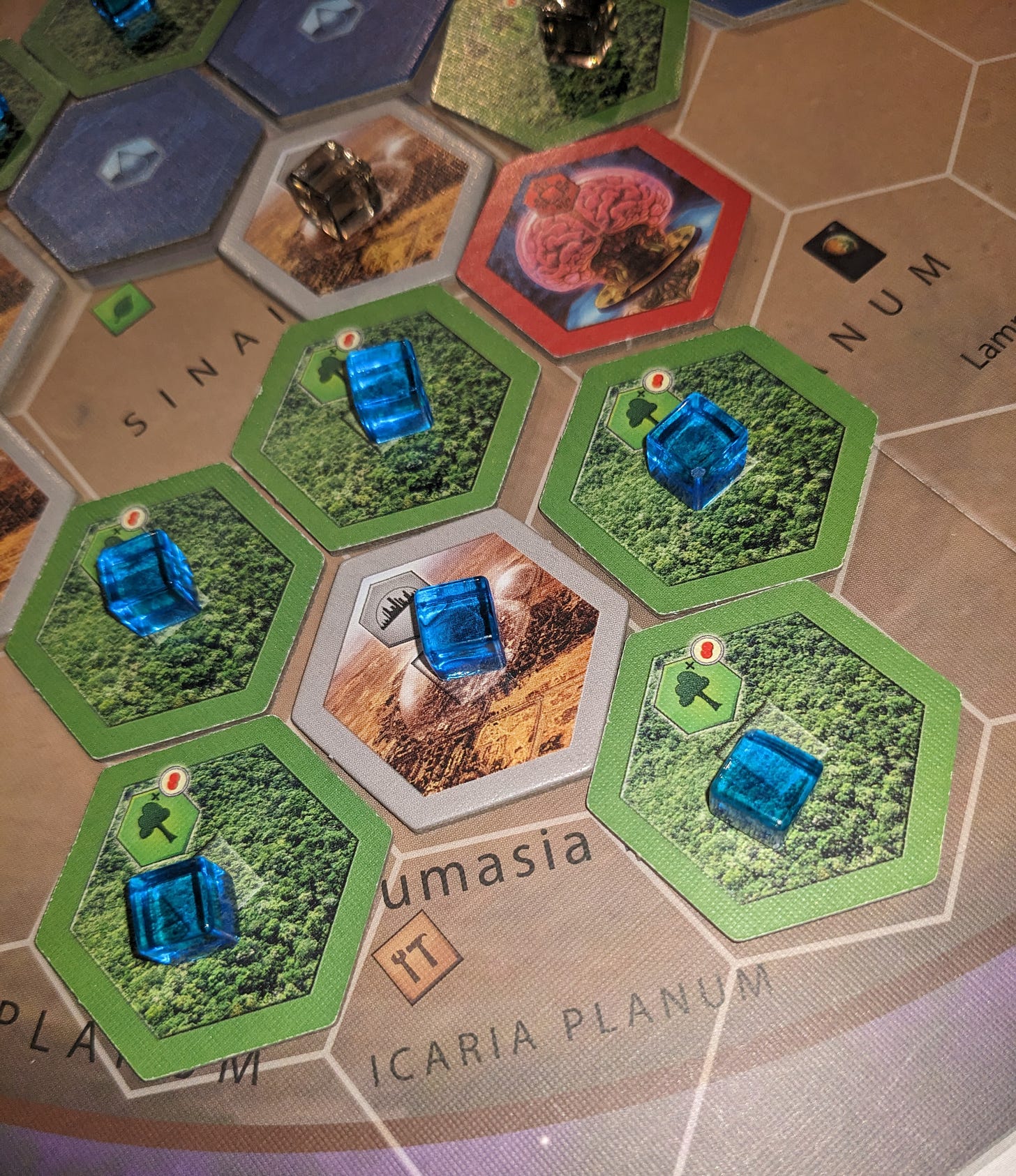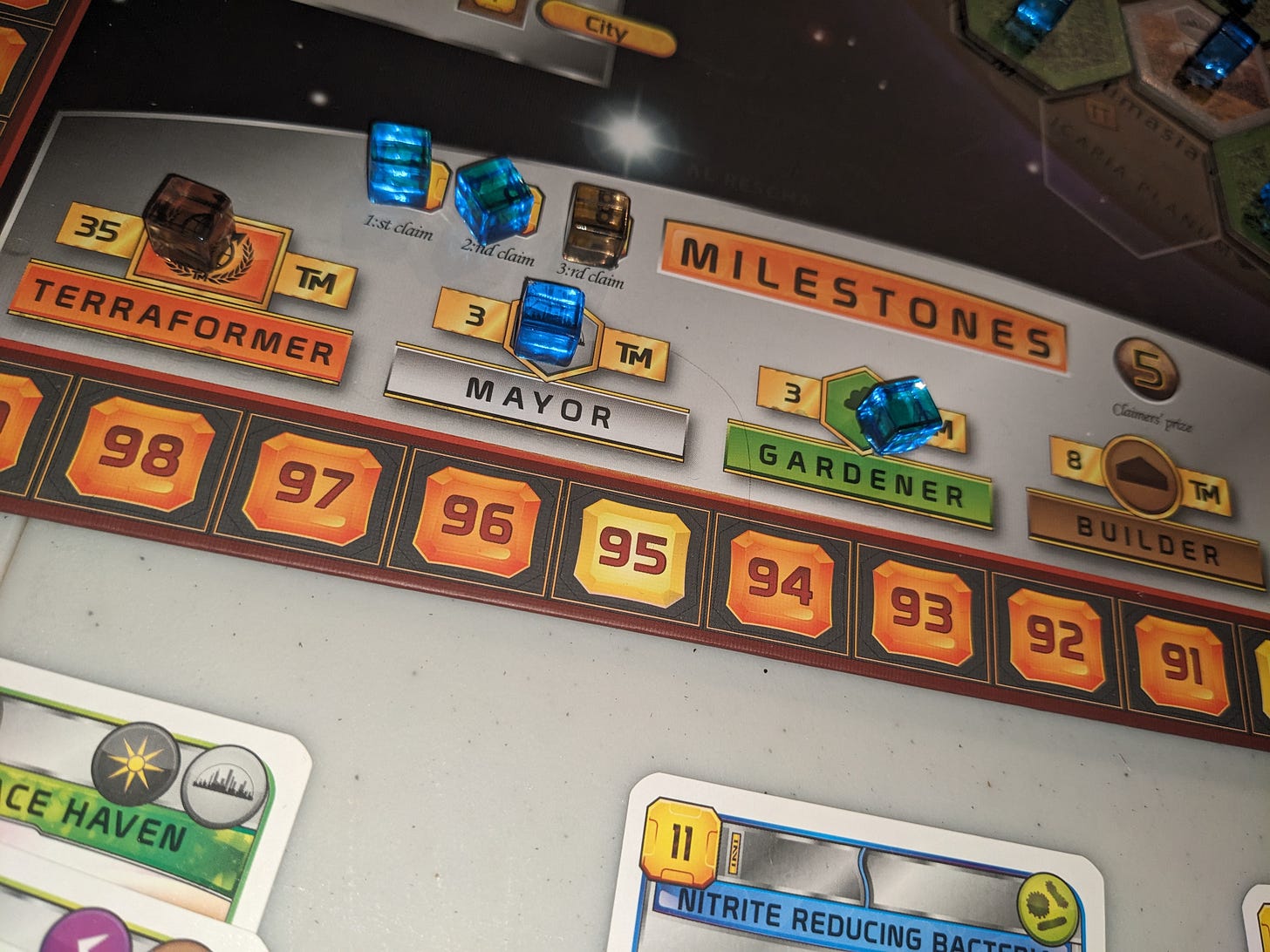How to Master Terraforming Mars: Automa
Master Terraforming Mars with effective strategies! Learn tips for resource management, optimizing actions, and creating powerful combos to improve your gameplay.
For the past few weeks, Terraforming Mars has been a mainstay on my table, providing an exciting and challenging experience. I’ve never spent this much time with the game, experimenting with different strategies and approaches. My initial games against the bot were tough, but with some strategy ideas I’ve gotten better.
Honestly, I haven't beaten the Marsbot yet, with my best score being 103 to 88. Despite the repeated losses, it's been an invaluable learning experience, helping me improve as a player and deepen my understanding of the game.
At the end of each game, I would stare at the wonderful planet Mars, wondering where I went wrong. Marsbot relentlessly builds cities and plants on the Martian surface. On top of that, their Neural Instance grants them an additional max of 6 points around each tile unless you strategically place your own tiles to block them.
Each generation feels like a battle filled with countless decisions. Should I purchase more cards or opt for a standard project instead? However, the longer you let generations pass or wait for better cards to appear, the more victory points the Marsbot AI will accumulate.
Here are some strategic tips and insights I've picked up along the way. While they won't ensure consistent wins, they will help you close the gap and put up a stronger challenge against the Marsbot or even against playing with friends and family.
Greenery Tiles
These greenery tiles are an essential part of gameplay as they help raise the oxygen level, contributing to the overall terraforming process. Each greenery tile placed grants the player one victory point at the end of the game and increases the oxygen level by 1%, earning a terraforming rating (TR) point. Strategically placing greenery tiles adjacent to your own cities can also yield extra points, making them a critical element for long-term scoring and positioning.
In the first generation, start placing greenery tiles early, as the Marsbot will soon begin placing its own tiles. This gives you a chance to get a head start and even aim for that milestone. Keep in mind that as your Terraforming Rating (TR) increases, you'll earn more mega credits during the production phase.
When choosing your initial hand of 10 cards, aim to select and purchase a maximum of 3 to 4 cards, depending on your corporation. Focus on cards that offer production benefits related to terraforming metrics, such as greenery or heat energy. Make sure to keep enough mega credits (MC) to place a greenery tile using the standard project. In the second generation, target placing another greenery tile, as your Terraforming Rating (TR) will gradually increase over time.
If you have the capacity to play some cards, go ahead and do so. This will allow you to start setting up your strategies for the upcoming generations.
Building Cities
As you raise oxygen levels by placing greenery tiles, it’s also important to strategically position city tiles. Each city should be placed next to greenery tiles, earning 1 victory point (VP) for each adjacent one.
Aiming to place three tiles in a triangle formation is a solid strategy, as it allows you to surround them with up to six greenery tiles. If your opponent places one of their tiles near your city, it even adds an extra point for you at no cost.
City tiles are expensive to build, but placing three cities is usually enough. With greenery tiles surrounding them, you can gain up to 6 victory points per city. Successfully placing 3 cities could therefore yield 18 points.
Unfortunately, cities don't directly add to Terraforming Mars (TM) points. Therefore, I’d avoid placing too many city tiles and would focus more on terraforming metrics like boosting oxygen and temperature. However, if you build a city using the standard project, you'll increase your MC production by one.
Milestones & Awards
Let’s not overlook milestones and awards, as the Marsbot aggressively targets these two features. This makes it essential to prioritize placing city and greenery tiles early in the game, which can help you secure important milestones and awards for up to 10 victory points.
While awards don't need immediate focus, as they’re claimed toward the end of the game, it’s wise to claim the Landlord Award if you're already expanding your land tiles—it can easily earn you an extra 5 victory points.
This can be easily 15 VPs.
Generations
Keep an eye on the number of generations that pass, as the Marsbot’s victory points can escalate quickly, making it essential to maintain steady progress and avoid stalling. By generations 12 to 15, the Marsbot can gain at least an additional 12 victory points.
Each generation should include tangible progress, either by placing tiles or advancing your TM metrics. If you don’t draw favorable cards, don’t feel pressured to buy them; instead, consider investing in the standard projects to place city and greenery tiles.
However, avoid completely disregarding cards. Once you start producing resources during production phases, like plants and heat, you can make good use of those cards to gain extra advantages.
Here are the scores from two games played, both resulting in losses. You’ll notice how the number of generations impacted the Marsbot’s final scores.
103 - 88 - (12 generations)
117 - 87 - (15 generations)
This Is Not Perfect
Some of these strategies might not be effective depending on the cards drawn for you and, more importantly, for the Marsbot. If the Marsbot accumulates a certain number of similar tags, it can advance quickly on the track, gaining cities, plants, and milestones. This is something you can’t control and might have to change strategy in the long process
Focusing too much on cities and plant tiles can come at the expense of raising the temperature. In one game, I played up to 15 generations because the temperature lagged behind while the oxygen level and ocean tiles progressed faster. Although the Marsbot helped raise the temperature, I fell behind after prioritizing cities and plants and claiming milestones early. In the meantime the Marsbot were just accumulating MCs throughout the generations.
Conclusion
Even though I lost, I found myself becoming a stronger and more competitive player. While these tips might seem obvious to experienced Terraforming Mars players, they’re especially important when facing the Marsbot’s aggressive playstyle.
Cards still play a crucial role for both you and the Marsbot. The drawn can significantly impact strategies and resources. For you, selecting the right cards and knowing when to invest in them can make a difference between a winning or losing game. Similarly, the Marsbot’s ability to effectively utilize its cards can amplify its progress, making it even more challenging to keep up.
I hope these strategies help you tackle the Marsbot. If any of these tips make a difference in your game, I’d love to hear your feedback—whether it’s positive or negative—in the comments. And if you have any additional strategies to share, please feel free to add them. It’s always interesting to see how others approach their path to victory!




